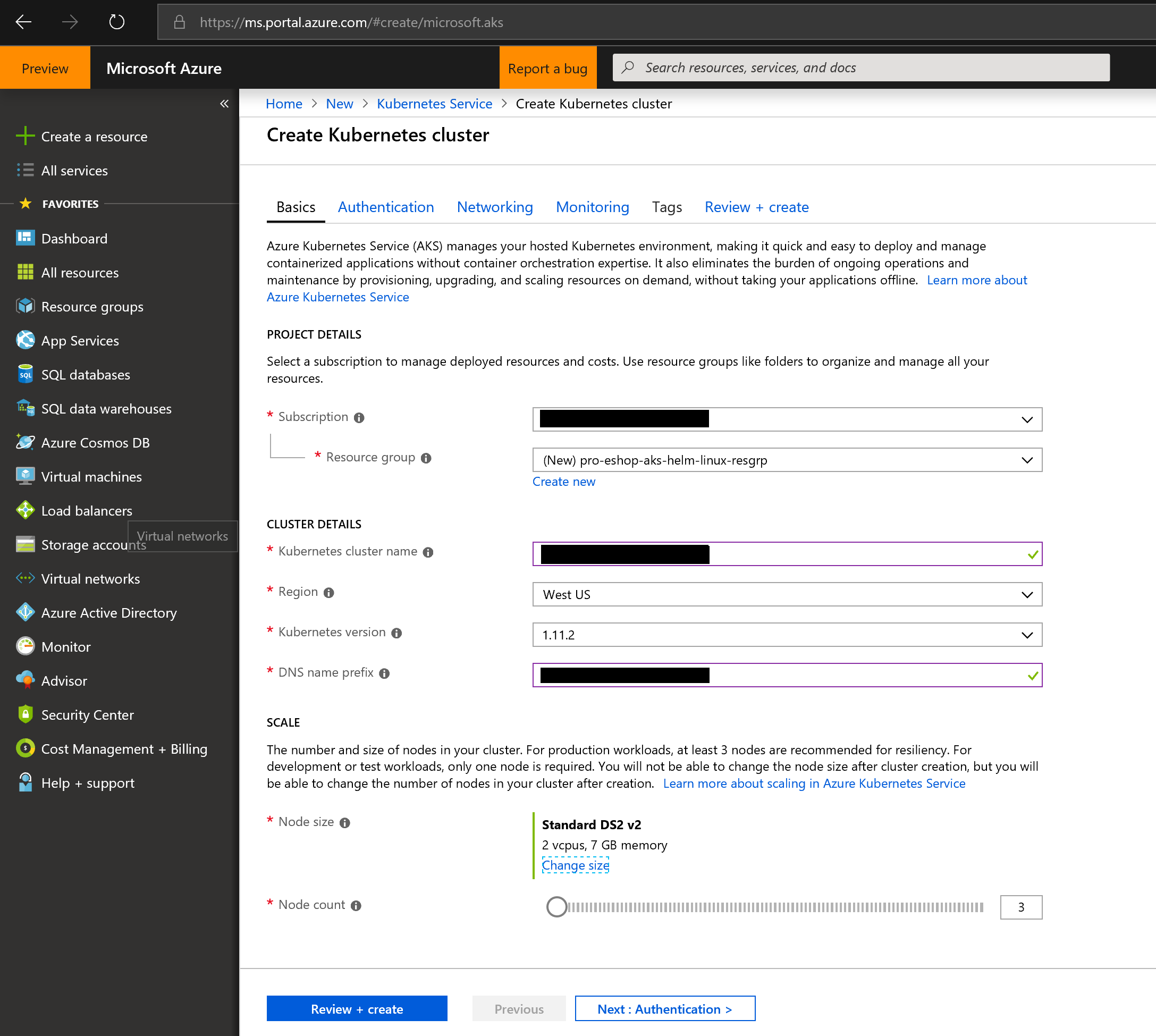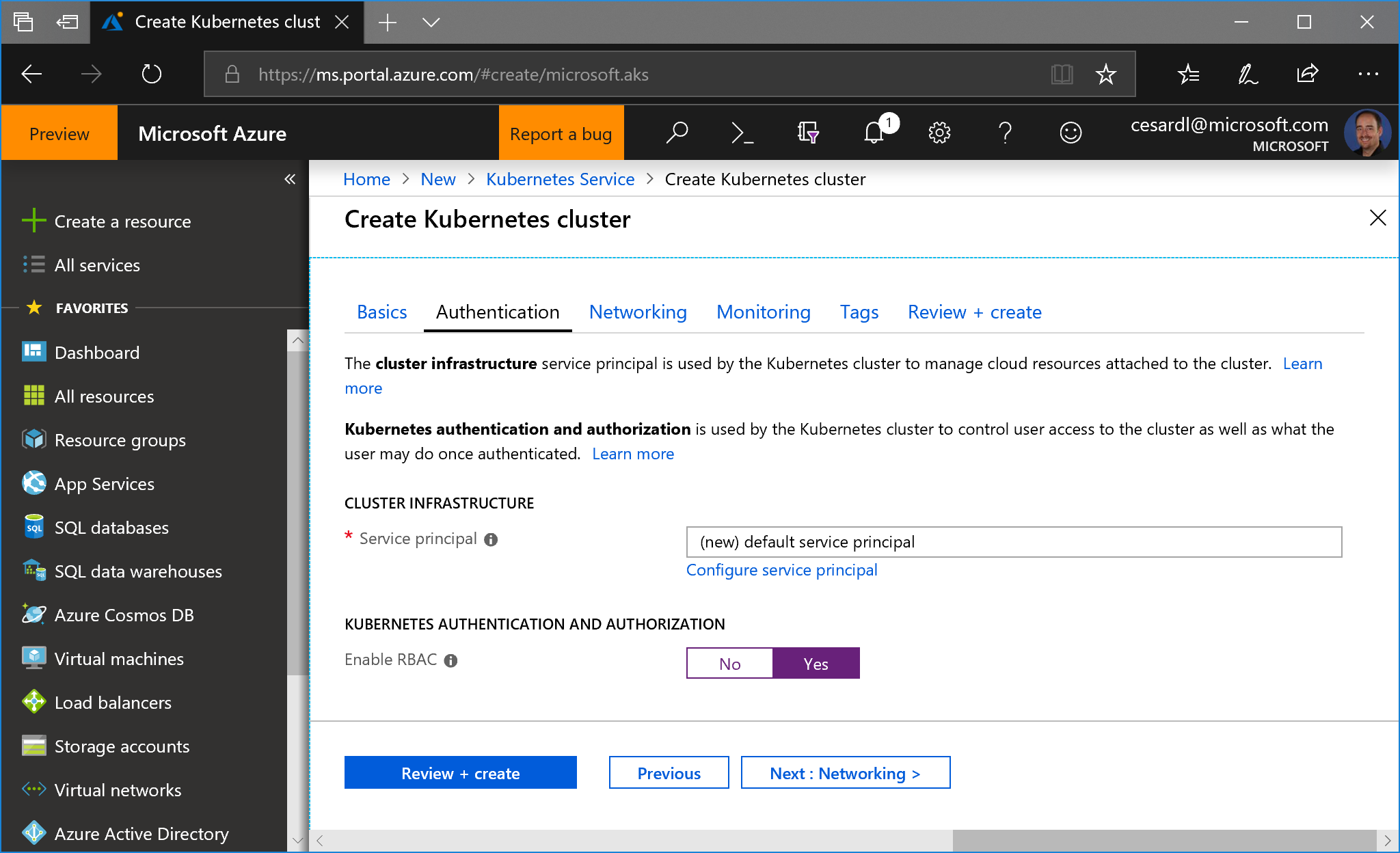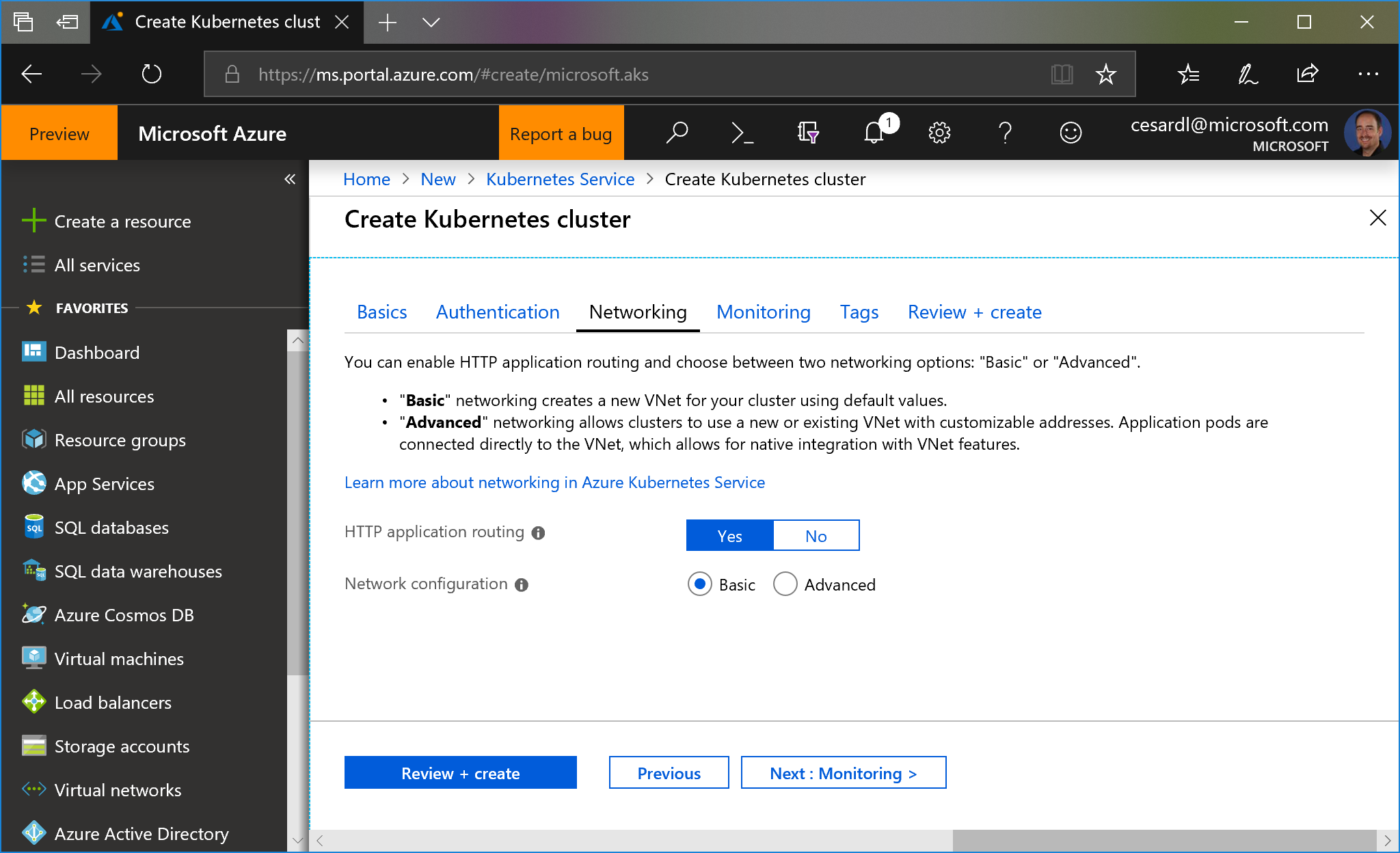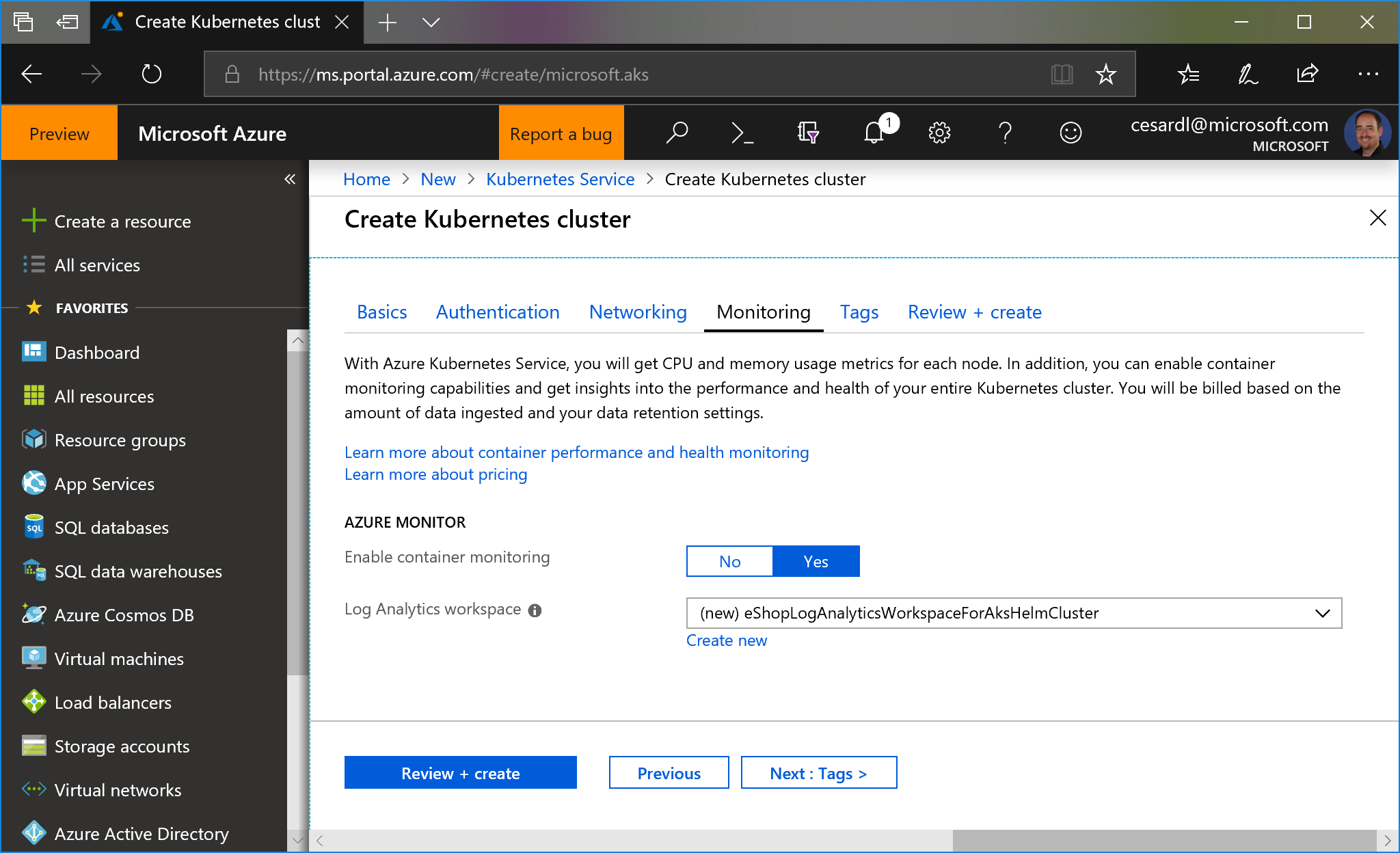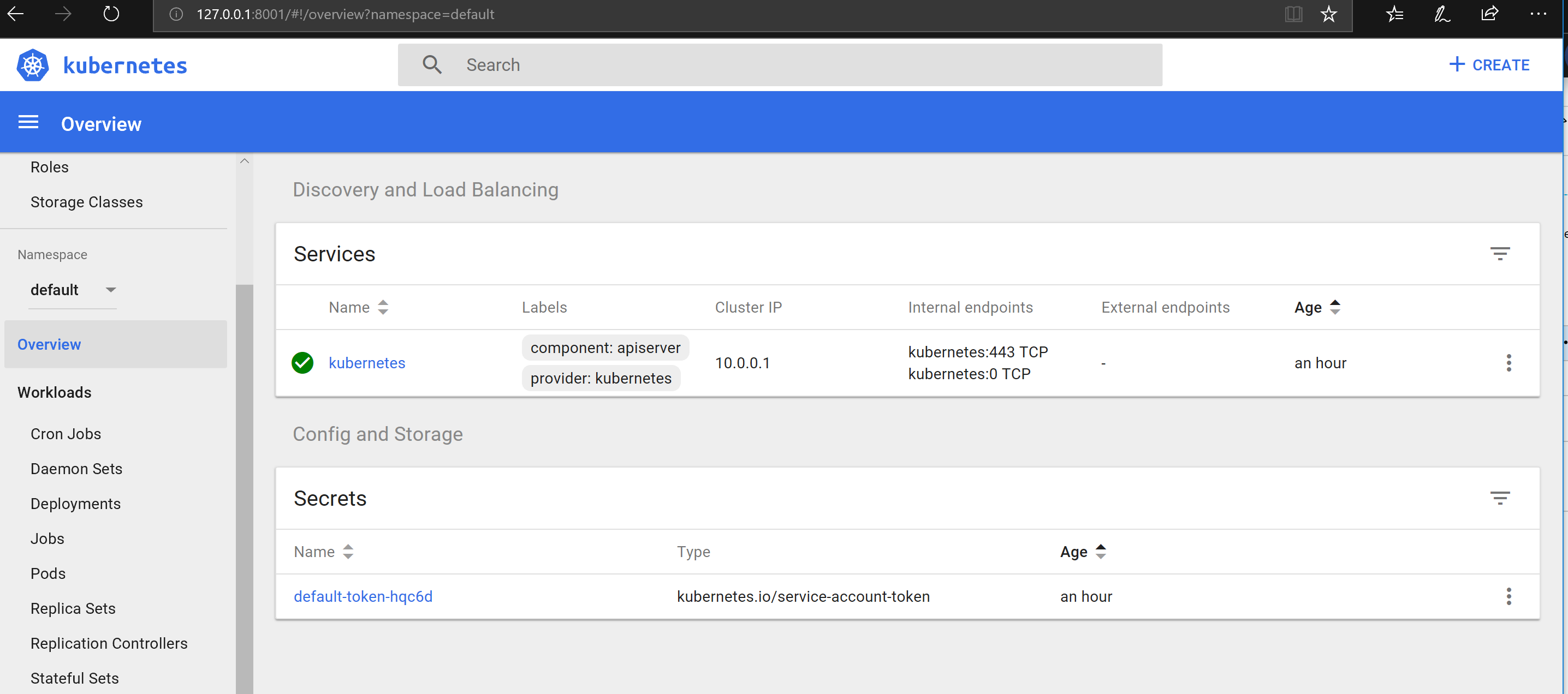23 KiB
Using Helm Charts to deploy eShopOnContainers to AKS with ISTIO
It is possible to deploy eShopOnContainers on a AKS using Helm instead of custom scripts (that will be deprecated soon).
Create Kubernetes cluster in AKS
You can create the AKS cluster by using two ways:
-
A. Use Azure CLI: Follow a procedure suing Azure CLI like here, but make sure you enable RBAC with
--enable-rbacinaz aks createcommand. -
B. Use Azure's portal
The following steps are using the Azure portal to create the AKS cluster:
- Start the process by providing the general data, like in the following screenshot:
- Then, very important, in the next step, enable RBAC:
You can use **basic network** settings since for a test you don't need integration into any existing VNET.
- You can also enable monitoring:
- Finally, create the cluster. It'll take a few minutes for it to be ready.
Configure RBAC security for K8s dashboard service-account
In order NOT to get errors in the Kubernetes dashboard, you'll need to set the following service-account steps.
Here you can see the errors you might see:
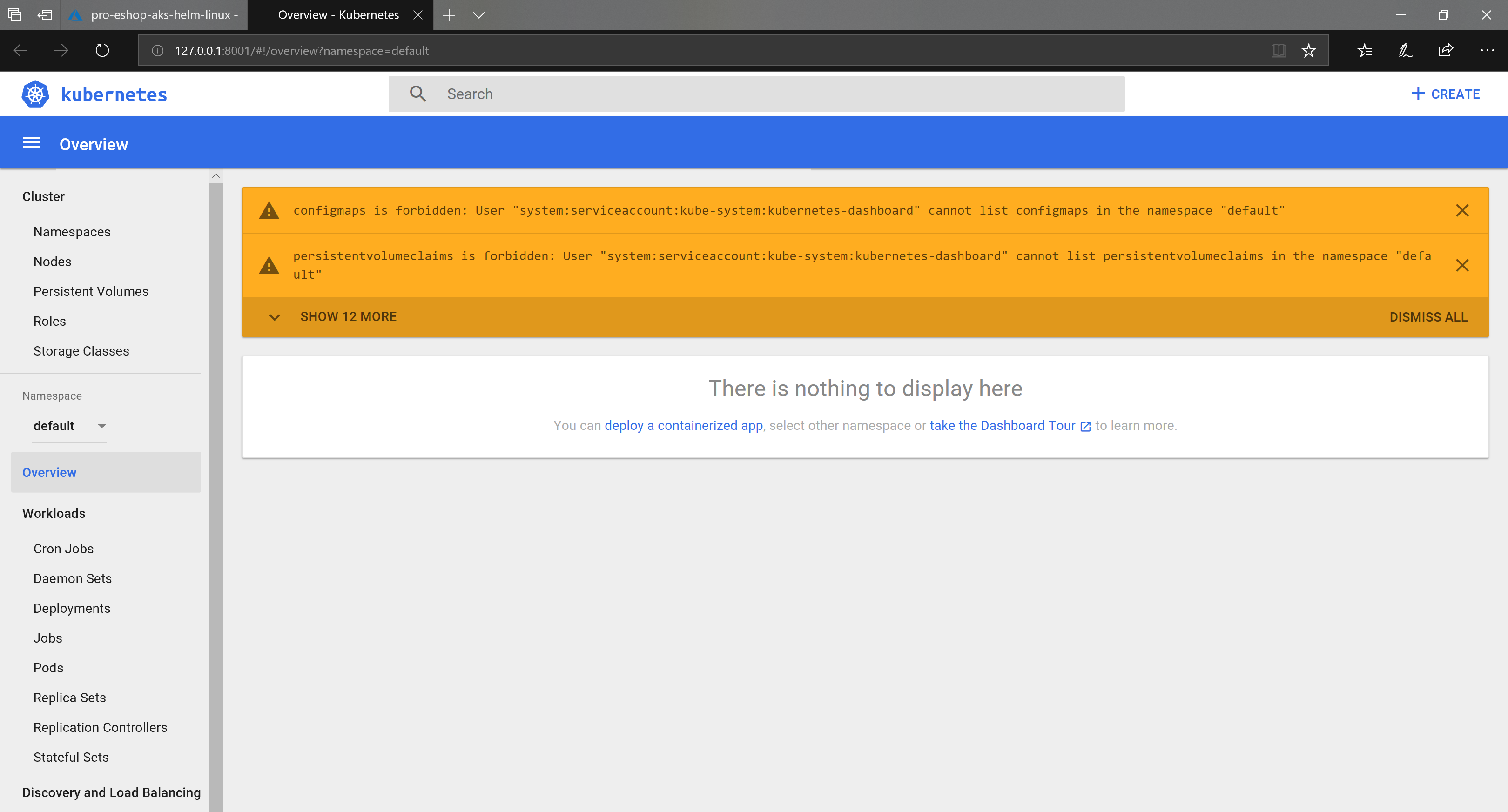
Now, just run the Azure CLI command to browse the Kubernetes Dashboard:
az aks browse --resource-group pro-eshop-aks-helm-linux-resgrp --name pro-eshop-aks-helm-linux
Additional pre-requisites
In addition to having an AKS cluster created in Azure and having kubectl and Azure CLI installed in your local machine and configured to use your Azure subscription, you also need the following pre-requisites:
Install Helm
You need to have helm installed on your machine, and Tiller must be installed on the AKS. Follow these instructions on how to 'Install applications with Helm in Azure Kubernetes Service (AKS)' to setup Helm and Tiller for AKS.
Note: If your ASK cluster is not RBAC-enabled (default option in portal) you may receive following error when running a helm command:
Error: Get http://localhost:8080/api/v1/namespaces/kube-system/configmaps?labelSelector=OWNER%!D(MISSING)TILLER: dial tcp [::1]:8080: connect: connection refused
If so, type:
kubectl --namespace=kube-system edit deployment/tiller-deploy
Your default text editor will popup with the YAML definition of the tiller deploy. Search for:
automountServiceAccountToken: false
And change it to:
automountServiceAccountToken: true
Save the file and close the editor. This should reapply the deployment in the cluster. Now Helm commands should work.
Install eShopOnContainers with Istio using Helm
All steps need to be performed on /k8s/helm folder. The easiest way is to use the deploy-all-istio.ps1 script from a Powershell window:
.\deploy-all-istio.ps1 -dnsname eshoptestistio -externalDns aks -aksName eshoptest -aksRg eshoptest -imageTag dev
This will install all the eShopOnContainers public images with tag dev on the AKS named eshoptest in the resource group eshoptest and with the dns url: http://eshoptestistio.westus.cloudapp.azure.com/ . By default all infrastructure (sql, mongo, rabbit and redis) is installed also in the cluster.
Once the script is run, you should see following output when using kubectl get deployment:
NAME DESIRED CURRENT UP-TO-DATE AVAILABLE AGE
eshop-apigwmm 1 1 1 1 4d
eshop-apigwms 1 1 1 1 4d
eshop-apigwwm 1 1 1 1 4d
eshop-apigwws 1 1 1 1 4d
eshop-basket-api 1 1 1 1 4d
eshop-basket-data 1 1 1 1 4d
eshop-catalog-api 1 1 1 1 4d
eshop-identity-api 1 1 1 1 4d
eshop-keystore-data 1 1 1 1 4d
eshop-locations-api 1 1 1 1 4d
eshop-marketing-api 1 1 1 1 4d
eshop-mobileshoppingagg 1 1 1 1 4d
eshop-nosql-data 1 1 1 1 4d
eshop-ordering-api 1 1 1 1 4d
eshop-ordering-backgroundtasks 1 1 1 1 4d
eshop-ordering-signalrhub 1 1 1 1 4d
eshop-payment-api 1 1 1 1 4d
eshop-rabbitmq 1 1 1 1 4d
eshop-sql-data 1 1 1 1 4d
eshop-webmvc 1 1 1 1 4d
eshop-webshoppingagg 1 1 1 1 4d
eshop-webspa 1 1 1 1 4d
eshop-webstatus 1 1 1 1 4d
Every public service is exposed through the istio ingress gateway.
Yo can see the ingress gateway public ip doing kubectl get services -n istio-system
grafana ClusterIP 10.0.204.87 <none> 3000/TCP 1h
istio-citadel ClusterIP 10.0.23.86 <none> 8060/TCP,9093/TCP 1h
istio-egressgateway ClusterIP 10.0.136.169 <none> 80/TCP,443/TCP 1h
istio-galley ClusterIP 10.0.113.51 <none> 443/TCP,9093/TCP 1h
istio-ingressgateway LoadBalancer 10.0.76.80 40.118.189.161 80:31380/TCP,443:31390/TCP,31400:31400/TCP,15011:31276/TCP,8060:30519/TCP,853:31698/TCP,15030:31453/TCP,15031:32362/TCP 1h
istio-pilot ClusterIP 10.0.164.253 <none> 15010/TCP,15011/TCP,8080/TCP,9093/TCP 1h
istio-policy ClusterIP 10.0.170.49 <none> 9091/TCP,15004/TCP,9093/TCP 1h
istio-sidecar-injector ClusterIP 10.0.251.12 <none> 443/TCP 1h
istio-telemetry ClusterIP 10.0.195.112 <none> 9091/TCP,15004/TCP,9093/TCP,42422/TCP 1h
jaeger-agent ClusterIP None <none> 5775/UDP,6831/UDP,6832/UDP 1h
jaeger-collector ClusterIP 10.0.123.98 <none> 14267/TCP,14268/TCP 1h
jaeger-query ClusterIP 10.0.244.146 <none> 16686/TCP 1h
kiali ClusterIP 10.0.182.12 <none> 20001/TCP 1h
prometheus ClusterIP 10.0.136.223 <none> 9090/TCP 1h
tracing ClusterIP 10.0.57.236 <none> 80/TCP 1h
zipkin ClusterIP 10.0.30.57 <none> 9411/TCP 1h
You can view the MVC client at http://[dns]/
Customizing the deployment
Using your own images
To use your own images instead of the public ones, you have to pass following additional parameters to the deploy-all-istio.ps1 script:
registry: Login server for the Docker registrydockerUser: User login for the Docker registrydockerPassword: User password for the Docker registry
This will deploy a secret on the cluster to connect to the specified server, and all image names deployed will be prepended with registry/ value.
Not deploying infrastructure containers
If you want to use external resources, use -deployInfrastructure $false to not deploy infrastructure containers. However you still have to manually update the scripts to provide your own configuration (see next section).
Providing your own configuration
The file inf.yaml contains the description of the infrastructure used. File is docummented so take a look on it to understand all of its entries. If using external resources you need to edit this file according to your needs. You'll need to edit:
inf.sql.hostwith the host name of the SQL Serverinf.sql.commonentries to provide your SQL user, password.Pidis not used when using external resources (it is used to set specific product id for the SQL Server container).inf.sql.catalog,inf.sql.ordering,inf.sql.identity: To provide the database names for catalog, ordering and identity servicesmongo.host: With the host name of the Mongo DBmongo.locations,mongo.marketingwith the database names for locations and marketing servicesredis.basket.constrwith the connection string to Redis for Basket Service. Note thatredis.basket.svcis not used when using external servicesredis.keystore.constrwith the connection string to Redis for Keystore Service. Note thatredis.keystore.svcis not used when using external serviceseventbus.constrwith the connection string to Azure Service Bus andeventbus.useAzuretotrueto use Azure service bus. Note thateventbus.svcis not used when using external services
Using Azure storage for Catalog Photos
Using Azure storage for catalog (and marketing) photos is not directly supported, but you can accomplish it by editing the file k8s/helm/catalog-api/templates/configmap.yaml. Search for lines:
catalog__PicBaseUrl: http://{{ $webshoppingapigw }}/c/api/v1/catalog/items/[0]/pic/
And replace it for:
catalog__PicBaseUrl: http://<url-of-the-storage>/
In the same way, to use Azure storage for the marketing service, have to edit the file k8s/helm/marketing-api/templates/configmap.yaml and replacing the line:
marketing__PicBaseUrl: http://{{ $webshoppingapigw }}/c/api/v1/catalog/items/[0]/pic/
by:
marketing__PicBaseUrl: http://<url-of-the-storage>/
Using Helm Charts to deploy eShopOnContainers to a local Kubernetes in Windows with 'Docker for Windows'
Additional pre-requisites
In addition to having Docker for Windows/Mac with Kubernetes enabled and having kubectl ayou also need the following pre-requisites:
Install Helm
You need to have helm installed on your machine, and Tiller must be installed on the local Docker Kubernetes cluster. Once you have Helm downloaded and installed on your machine you must:
- Create the tiller service account, by running
kubectl apply -f helm-rbac.yamlfrom/k8sfolder - Install tiller and configure it to use the tiller service account by typing
helm init --service-account tiller
Install eShopOnContainers with Istio using Helm
All steps need to be performed on /k8s/helm folder. The easiest way is to use the deploy-all-istio.ps1 script from a Powershell window:
.\deploy-all-istio.ps1 -imageTag dev -useLocalk8s $true
The parameter useLocalk8s to $true, forces the script to use localhost as the DNS for all Helm charts.
This will install all the eShopOnContainers public images with tag dev on the Docker local Kubernetes cluster. By default all infrastructure (sql, mongo, rabbit and redis) is installed also in the cluster.
Once the script is run, you should see following output when using kubectl get deployment:
NAME DESIRED CURRENT UP-TO-DATE AVAILABLE AGE
eshop-apigwmm 1 1 1 1 2h
eshop-apigwms 1 1 1 1 2h
eshop-apigwwm 1 1 1 1 2h
eshop-apigwws 1 1 1 1 2h
eshop-basket-api 1 1 1 1 2h
eshop-basket-data 1 1 1 1 2h
eshop-catalog-api 1 1 1 1 2h
eshop-identity-api 1 1 1 1 2h
eshop-keystore-data 1 1 1 1 2h
eshop-locations-api 1 1 1 1 2h
eshop-marketing-api 1 1 1 1 2h
eshop-mobileshoppingagg 1 1 1 1 2h
eshop-nosql-data 1 1 1 1 2h
eshop-ordering-api 1 1 1 1 2h
eshop-ordering-backgroundtasks 1 1 1 1 2h
eshop-ordering-signalrhub 1 1 1 1 2h
eshop-payment-api 1 1 1 1 2h
eshop-rabbitmq 1 1 1 1 2h
eshop-sql-data 1 1 1 1 2h
eshop-webmvc 1 1 1 1 2h
eshop-webshoppingagg 1 1 1 1 2h
eshop-webspa 1 1 1 1 2h
eshop-webstatus 1 1 1 1 2h
Note that istio ingress gateway is bound to DNS localhost and the host is also "localhost". So, you can access the webspa by typing http://localhost and the MVC by typing http://localhost/
As this is the Docker local K8s cluster, you can see also the containers running on your machine. If you type docker ps you'll see all them:
CONTAINER ID IMAGE COMMAND CREATED STATUS PORTS NAMES
fec1e3499416 a3f21ec4bd11 "/entrypoint.sh /ngi…" 9 minutes ago Up 9 minutes k8s_nginx-ingress-controller_nginx-ingress-controller-f88c75bc6-5xs2n_ingress-nginx_f1cc7094-e68f-11e8-b4b6-00155d016146_0
76485867f032 eshop/payment.api "dotnet Payment.API.…" 2 hours ago Up 2 hours k8s_payment-api_eshop-payment-api-75d5f9bdf6-6zx2v_default_4a3cdab4-e67f-11e8-b4b6-00155d016146_1
c2c4640ed610 eshop/marketing.api "dotnet Marketing.AP…" 2 hours ago Up 2 hours k8s_marketing-api_eshop-marketing-api-6b8c5989fd-jpxqv_default_45780626-e67f-11e8-b4b6-00155d016146_1
85301d538574 eshop/ordering.signalrhub "dotnet Ordering.Sig…" 2 hours ago Up 2 hours k8s_ordering-signalrhub_eshop-ordering-signalrhub-58cf5ff6-cnlm8_default_4932c344-e67f-11e8-b4b6-00155d016146_1
7a408a98000e eshop/ordering.backgroundtasks "dotnet Ordering.Bac…" 2 hours ago Up 2 hours k8s_ordering-backgroundtasks_eshop-ordering-backgroundtasks-cc8f6d4d8-ztfk7_default_47f9cf10-e67f-11e8-b4b6-00155d016146_1
12c64b3a13e0 eshop/basket.api "dotnet Basket.API.d…" 2 hours ago Up 2 hours k8s_basket-api_eshop-basket-api-658546684d-6hlvd_default_4262d022-e67f-11e8-b4b6-00155d016146_1
133fccfeeff3 eshop/webstatus "dotnet WebStatus.dll" 2 hours ago Up 2 hours k8s_webstatus_eshop-webstatus-7f46479dc4-bqnq7_default_4dc13eb2-e67f-11e8-b4b6-00155d016146_0
00c6e4c52135 eshop/webspa "dotnet WebSPA.dll" 2 hours ago Up 2 hours k8s_webspa_eshop-webspa-64cb8df9cb-dcbwg_default_4cd47376-e67f-11e8-b4b6-00155d016146_0
d4507f1f6b1a eshop/webshoppingagg "dotnet Web.Shopping…" 2 hours ago Up 2 hours k8s_webshoppingagg_eshop-webshoppingagg-cc94fc86-sxd2v_default_4be6cdb9-e67f-11e8-b4b6-00155d016146_0
9178e26703da eshop/webmvc "dotnet WebMVC.dll" 2 hours ago Up 2 hours k8s_webmvc_eshop-webmvc-985779684-4br5z_default_4addd4d6-e67f-11e8-b4b6-00155d016146_0
1088c281c710 eshop/ordering.api "dotnet Ordering.API…" 2 hours ago Up 2 hours k8s_ordering-api_eshop-ordering-api-fb8c548cb-k68x9_default_4740958a-e67f-11e8-b4b6-00155d016146_0
12424156d5c9 eshop/mobileshoppingagg "dotnet Mobile.Shopp…" 2 hours ago Up 2 hours k8s_mobileshoppingagg_eshop-mobileshoppingagg-b54645d7b-rlrgh_default_46c00017-e67f-11e8-b4b6-00155d016146_0
65463ffd437d eshop/locations.api "dotnet Locations.AP…" 2 hours ago Up 2 hours k8s_locations-api_eshop-locations-api-577fc94696-dfhq8_default_44929c4b-e67f-11e8-b4b6-00155d016146_0
5b3431873763 eshop/identity.api "dotnet Identity.API…" 2 hours ago Up 2 hours k8s_identity-api_eshop-identity-api-85d9b79f4-s5ks7_default_43d6eb7c-e67f-11e8-b4b6-00155d016146_0
7c8e77252459 eshop/catalog.api "dotnet Catalog.API.…" 2 hours ago Up 2 hours k8s_catalog-api_eshop-catalog-api-59fd444fb-ztvhz_default_4356705a-e67f-11e8-b4b6-00155d016146_0
94d95d0d3653 eshop/ocelotapigw "dotnet OcelotApiGw.…" 2 hours ago Up 2 hours k8s_apigwws_eshop-apigwws-65474b979d-n99jw_default_41395473-e67f-11e8-b4b6-00155d016146_0
bc4bbce71d5f eshop/ocelotapigw "dotnet OcelotApiGw.…" 2 hours ago Up 2 hours k8s_apigwwm_eshop-apigwwm-857c549dd8-8w5gv_default_4098d770-e67f-11e8-b4b6-00155d016146_0
840aabcceaa9 eshop/ocelotapigw "dotnet OcelotApiGw.…" 2 hours ago Up 2 hours k8s_apigwms_eshop-apigwms-5b94dfb54b-dnmr9_default_401fc611-e67f-11e8-b4b6-00155d016146_0
aabed7646f5b eshop/ocelotapigw "dotnet OcelotApiGw.…" 2 hours ago Up 2 hours k8s_apigwmm_eshop-apigwmm-85f96cbdb4-dhfwr_default_3ed7967a-e67f-11e8-b4b6-00155d016146_0
49c5700def5a f06a5773f01e "docker-entrypoint.s…" 2 hours ago Up 2 hours k8s_basket-data_eshop-basket-data-66fbc788cc-csnlw_default_3e0c45fe-e67f-11e8-b4b6-00155d016146_0
a5db4c521807 f06a5773f01e "docker-entrypoint.s…" 2 hours ago Up 2 hours k8s_keystore-data_eshop-keystore-data-5c9c85cb99-8k56s_default_3ce1a273-e67f-11e8-b4b6-00155d016146_0
aae88fd2d810 d69a5113ceae "docker-entrypoint.s…" 2 hours ago Up 2 hours k8s_rabbitmq_eshop-rabbitmq-6b68647bc4-gr565_default_3c37ee6a-e67f-11e8-b4b6-00155d016146_0
65d49ca9589d bbed8d0e01c1 "docker-entrypoint.s…" 2 hours ago Up 2 hours k8s_nosql-data_eshop-nosql-data-579c9d89f8-mtt95_default_3b9c1f89-e67f-11e8-b4b6-00155d016146_0
090e0dde2ec4 bbe2822dfe38 "/opt/mssql/bin/sqls…" 2 hours ago Up 2 hours k8s_sql-data_eshop-sql-data-5c4fdcccf4-bscdb_default_3afd29b8-e67f-11e8-b4b6-00155d016146_0
Known issues
Login from the webmvc results in following error: HttpRequestException: Response status code does not indicate success: 404 (Not Found).
The reason is because MVC needs to access the Identity Server from both outside the container (browser) and inside the container (C# code). Thus, the configuration uses always the external url of the Identity Server, which in this case is just http://localhost/identity-api. But this external url is incorrect when used from C# code, and the web mvc can't access the identity api. This is the only case when this issue happens (and is the reason why we use 10.0.75.1 for local address in web mvc in local development mode)
Solving this requires some manual steps:
Update the configmap of Web MVC by typing (line breaks are mandatory) and your cluster dns name has to be the same of your environment:
kubectl patch cm cfg-eshop-webmvc --type strategic --patch @'
data:
urls__IdentityUrl: http://**eshoptest**.westus.cloudapp.azure.com/identity
urls__mvc: http://**eshoptest**.westus.cloudapp.azure.com/webmvc
'@
Update the configmap of Identity API by typing (line breaks are mandatory):
kubectl patch cm cfg-eshop-identity-api --type strategic --patch @'
data:
mvc_e: http://**eshoptest**.westus.cloudapp.azure.com/webmvc
'@
Restart the SQL Server pod to ensure the database is recreated again:
kubectl delete pod --selector app=sql-data
Wait until SQL Server pod is ready to accept connections and then restart all other pods:
kubectl delete pod --selector="app!=sql-data"
Note: Pods are deleted to ensure the databases are recreated again, as identity api stores its client names and urls in the database.
Now, you can access the MVC app using: http://**eshoptest**.westus.cloudapp.azure.com/.
